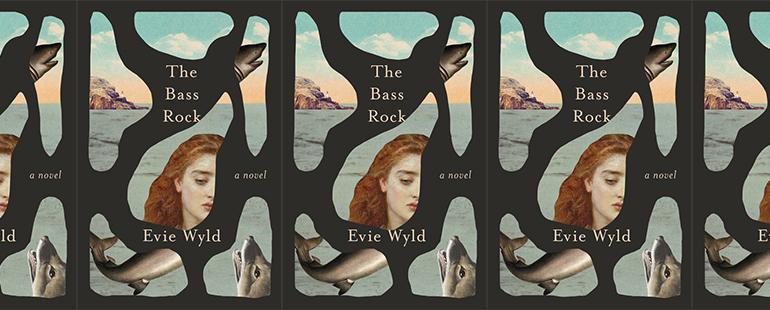The Bass Rock’s Layered Use of Setting

In Evie Wyld’s third novel, The Bass Rock, published last year, three narratives are braided together to tell a unified story of the damage done to women by men, and the way that women can support each other in return. The three narratives are set in different times: the 18th century, post-WWII, and the present moment; the unique setting ties the narratives together in an intricate fashion.
The novel is named for a volcanic plug—the core of an old volcano—in the Firth of Forth, twenty-five miles from Edinburgh, near the town of North Berwick, and a mile or so off the Scottish coast. The Bass Rock looms over the novel, a hulking presence that is always seen and felt and yet never visited. The natural setting in this novel is as important as any of the characters, a gothic and often windswept place that never changes, even as the world changes around it. It is a place of contradictions—beautiful yet dark, placid yet troubled—and holds many stories and histories, all of which come to bear on Wyld’s narrative.
The novel consists of seven sections, each named for places in North Berwick. Four of them (The Lamb, The Sisters, The Sow, and Fidra) are islands or outcroppings in the Firth of Forth. The two larger islands—the Bass Rock and Fidra—are home to the world’s largest population of gannets. Gannets were recorded there as far back as the 15th century; today, well over 150,000 birds return each spring and summer, their bodies crowded onto the rocky outpost, turning the island white. They are so connected to the Bass Rock that their scientific name—Morus bassanus—takes its name from the rock. The birds appear throughout the novel, often in connection with the Bass Rock: “She would take a walk along the golf course to the sand, and see the rock hunkering down under its white coating of gannet mess,” Wyld writes. “There was a feeling, though, of something forgotten, something out of reach, a nagging disorder or wrongness.”
The remaining three sections are named for other local places, including St. Baldred’s, the Episcopal church that was built in the mid-19th century as the train arrived and the town became a seaside destination for the wealthy. It is named for St. Baldred, a hermit who lived on the rock but also in a cave on the mainland shore; The Cave is another section name. As legend has it, when St. Baldred died in 757, three wrapped bodies, ready for burial, were found on the rock, and so three local churches buried him and built shrines. It is perhaps not a coincidence that there are three narratives in this novel.
The Law, another section title, is the Scottish name for hill, and it is the formal name for the hill that sits just outside of the center of North Berwick; it is also a volcanic plug. Of all the locations used as section titles, the Law is the place that is visited by multiple characters, and it, like the Bass Rock, is a looming presence, although a hike up to its top allows for a scenic, if blustery, view of the landscape as a whole. The jawbone of a whale has stood on top of the hill since 1709. These section names do not speak directly to the stories contained in each section but serve more as a reminder of how the landscape is ever-present and shared over time, and how it functions to tie the narratives together.
Wyld structures the novel to move between the three narratives in a distinct pattern. Within each section, the chapters are as follows: Chapter I, Chapter II, Chapter III, Chapter II, Chapter I. This corresponds to the three timelines: Chapter I belongs to Viviane, in the present; Chapter II to Ruth, in post-WWII; and Chapter III to Sarah, in the early 18th century. Within each section, then, we first move backwards and then forwards in time. Viviane and Ruth’s stories take up most of the narrative and are connected: Ruth is Viviane’s step-grandmother, and Viviane is charged with cleaning up the grand house in North Berwick where Ruth lived, a house that has a clear view of the Bass Rock. They inhabit the same space, albeit at different times, and their stories are intertwined: objects and people from one storyline are often found later in the other. Both women are struggling with grief and with trauma. Sarah is too—raped and accused of being a witch, her story is the pinnacle of each section. There is a rising and falling that occurs in this method of structuring the narrative that feels as though it is echoing the landscape. The Bass Rock juts out of the flatness of the sea; the mainland is relatively flat, too—golf courses abound—but the Law mimics the Bass Rock in the way that it almost appears out of nowhere, hovering over the town. There is also, in this structuring, a feel of the sea, of the way that the tide flows in and then out again, repeating endlessly over time.
Sarah’s story stands a bit apart from the other two; it feels like an origin story, of sorts. Her story is told by a boy, Joseph, whose family rescues Sarah after she is accused of being a witch. The family leaves the village and heads through the Scottish woods towards the sea, towards the rock, to start their lives over. Slightly more than a hundred years earlier, North Berwick was the home to the witch trials of 1590. Over seventy people were accused. The witches supposedly held their covens on the Auld Kirk Green; remains of this building are extant at the North Berwick harbor. These witches became immortalized in Macbeth: Shakespeare learned of them from the Daemonologie by King James, which laid out the events surrounding the witch trials, and both the witches and the Scottish setting were borrowed from this event.
Wyld is clearly drawing a line that connects the witches and the witch hunts to the women who, throughout the ages, have been mistreated and abused. In the novel, she connects Sarah to the present day by bringing her into Ruth’s narrative as a ghost: “She did not see the girl standing by the window. She did not see her red hair and white face and the dark hollows of her eyes, or the rags she was dressed in, her bare angular feet and the bones of her hands protruding out like sticks.” Ghosts, in this novel, are never simply imaginative; they are real characters. Sarah stays with Ruth, in the house, as Ruth’s marriage dissolves, and as she becomes a step-grandmother to Viviane. As Ruth holds baby Viviane, Sarah close by, “the rain fell harder, making the rose heads in the garden shudder. She could see it out on the Bass Rock, the rain coming down like a lace veil that made the edges blend into the clouds.” The three narratives converge into one.
Before and after each of the main sections are small vignettes of girls and women, either murdered or in danger of being murdered. The first one, the one that starts the novel, is Viviane as a child, finding a dead woman with painted nails in a suitcase on the beach. From this point on, these vignettes are ordered chronologically, from pre-historic times to the present. In every one, the Bass Rock is present. The second vignette begins as follows:
The girl lies with dirt in her mouth, naked from the waist down. To find her, a dog is needed, and a man with it. She has walked further from the village than she intended. No one comes.
Instead a jackdaw comes from its roost where it sees from the forest to the great rock in the sea, where it maybe saw the violence and waited, thinking in its bird’s brain how this is the nature of man and soon it will be over and soon there will be meat.
These vignettes are violent and unsparing in their gaze; the use of present tense makes each one come alive in horrific detail. Combined, the vignettes serve as a montage of North Berwick over thousands of years: the details may change, but the treatment of women remains shockingly the same.
In the present-day narrative, Viviane’s story ends in a slightly more positive vein: she has re-established bonds with her mother and her sister, and she seems to be in a better place. Out for a walk with her family, she leaves them at the shore and goes inland, to a small wood. The Bass Rock, so ever-present, is no longer in view. She hears the whistle of the Edinburgh train and she stands still among the trees, calling out hello, “just to hear if my voice echoes back. It does, three times.”
The use of place in this novel underscores the constant nature of violence against women—that unchanging and immoveable landscape—and yet the capacity for women to band together in order to fight back shows that there may, indeed, be better days ahead.



